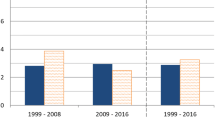Abstract
The credibility of exchange rate target zones for four EMS countries for the period March 1979-September 1992 is examined. Existing methods by Svensson, Edin and Vredin, typically applied to data from the Nordic countries, are considered. On balance, the method suggested by Edin and Vredin provides somewhat better estimates of devaluation probabilities than either of Svensson's methods. While all methods produce reasonably good estimates of the expected size of devaluations, they did not predict the September 1992 EMS crisis. However, we find that electoral and other institutional variables improve estimates of devaluation expectations.
Similar content being viewed by others
References
Alesina, A. (1988) “Macroeconomics and Politics”. In S. Fischer (ed)NBER Macroeconomics Annual. Cambridge: MIT Press, p. 13–51.
Bartolini, L. and G. Bodnar (1992) “Target Zones and Forward Rates in a Model with Repeated Realignments,”International Monetary Fund Working Paper 92/22.
Branson, W.H. (1994) “Comments on Rose and Svensson”,European Economic Review 38, 1217–1220.
Burdekin, R.C.K. (1993) “Inflation, Output and Wages in Europe, 1971–1989: Did Membership in the European Monetary System Matter?” manuscript, Claremont Graduate School.
Burdekin, R.C.K., J. Westbrook and T.D. Willett (1994) “Exchange Rate Pegging as a Disinflation Strategy: Evidence from the EMS”. In P.L. Siklos (ed)Varieties of Monetary Reforms: Lessons and Experiences on the Road to Monetary Union. Dordrecht: Kluwer Academic Publishers, pp. 45–72.
Caramazza, F. (1993) “French-German Interest Rate Differentials and Time-Varying Realignment Risk”,IMF Staff Papers 40, 567–583.
Chen, Z. and A. Giovannini (1993) “The Determinants of Realignment Expectations under the EMS: Some Empirical Results”NBER Working Paper No. 4291.
Dumas, B. and L.E.O. Svensson (1994) “How Long Do Unilateral Target Zones Last”DELTA Working Paper 94-06.
Edin, P.A. and A. Vredin (1993) “Devaluation Risk in Target Zones: Evidence from the Nordic Countries”Economic Journal 103, 161–175.
Eichengreen, B. and C. Wyplosz (1993) “The Ustable EMS,”Brookings Papers on Economic Activity 1, 51–44.
Flood, R.P., A.K. Rose, and D.J. Mathieson (1993) “An Empirical Exploration of Exchange Rate Target Zones,”Carnegie-Rochester Conference Series on Public Policy 35, 7–65.
Gardner, E.H. and W.R.M. Perraudin (1993) “Asymmetry in the ERM”,IMF Staff Papers 40, 427–50.
Gärtner, M. (1993)Macroeconomics under Flexible Exchange Rates. New York: Harvester-Wheatsheaf.
Grabbe, J.O. (1991)International Financial Markets, second edition. Amsterdam: Elsevier Science Publishers.
Greene, W.H. (1993)Econometric Analysis, second edition, New York: MacMillan Publishing Co.
Heckman, J.J. (1979) “Sample Selection Bias as a Specification Error”,Econometrica 47, 153–161.
Kaminsky, G. and R. Peruga (1990) “Can a Time Varying Premium Explain Excess Returns in the Forward Market for Foreign Exchange?”Journal of International Economics 28, 47–70.
Krugman, P. (1991) “Target Zones and Exchange Rate Dynamics”Quarterly Journal of Economics 106, 669–682.
Krugman, P. and M.H. Miller (1991) “Why Have a Target Zone?”Carnegie-Rochester Conference Series on Public Policy.
Krugman, P. and J. Rotemberg (1990) “Target Zones with Limited Reserves”.NBER Working Paper No. 3418.
Lindberg, H., P. Soderlind, and L.E.O. Svensson (1993) “Devaluation Expectations: The Swedish Krona 1985–1992”,Economic Journal 103, 1170–1179.
McCallum, B.T. (1994) “A Reconsideration of the Uncovered Interest Rate Parity Relationship”,Journal of Monetarv Economics 33, 105–132.
Mindford, P. (1993) “The Political Economy of the Exchange Rate Mechanism,”CEPR Working Paper No. 774.
Molle, W. (1990)The Economics of European Integration. Aldershot: Dartmouth.
Neely, C.J. (1994) “Redevelopment of Target Zone Exchange Rate Systems: What Do We Know?”Review of the Federal Reserve Bank of St. Louis 76, 23–34.
Rose, A.K. and L.E.O. Svennson (1991) “Expected and Predicted Realignments: The FF/DM Exchange Rate During the EMS,”Institute for International Economic Studies Seminar Paper 485.
Rose, A.K., and L.E.O. Svensson (1994) “European Exchange Rate Credibility After the Fall”European Economic Review 8, 1185–1216.
Svensson, L.E.O. (1994) “Fixed Exchange Rates as a Means to Price Stability: What Have Learned?”NBER Working Paper No. 4504.
Svensson, L.E.O. (1993) “Assessing Target Zone Credibility: Mean Reversion and Devalaution Expectations in the EMS 1973–1992,”European Economic Review 37, 763–793.
Svensson, L.E.O. (1992a) “An Interpretation of Resent Research on Exchange Rate Target Zones,”Journal of Economic Perspectives 6, 119–144.
Svensson, L.E.O. (1992b) “The Foreign Exchange Risk Premium in Target Zone with Devaluation Risk”,Journal of International Economics 33, 21–40.
Svensson, L.E.O. (1992c) “Why Exchange Rate Bands? Monetary Independence in Spite of Fixed Exchange Rates”,NBER Working Paper No. 4207.
Svensson, L.E.O. (1991b) “The Simplest Test of Target Zone Credibility”,IMF Staff Papers, 38, 655–665.
Svensson, L.E.O. (1991b) “The Tetm Sttucture of Interest Rates in a Target Zone: Theory and Evidence,”Journal of Monetary Economics 28, 87–116.
Tabellini, G. (1994) “Comments on Rose and Svensson (1994),”European Economic Review 38, 1221–1223.
Taylor, M.P. (1995) “The Economics of Exchange Rates,”Journal of Economic Literature 33, 13–47.
White, K.J. (1993)Shazam: Econometric Computer Program, version 7.0, User's Reference Manual. New York: McGraw-Hill.
Author information
Authors and Affiliations
Rights and permissions
About this article
Cite this article
Siklos, P.L., Tarajos, R. Fundamentals and devaluation expectations in target zones: Some new evidence from the ERM. Open Econ Rev 7, 35–59 (1996). https://doi.org/10.1007/BF01886128
Issue Date:
DOI: https://doi.org/10.1007/BF01886128




